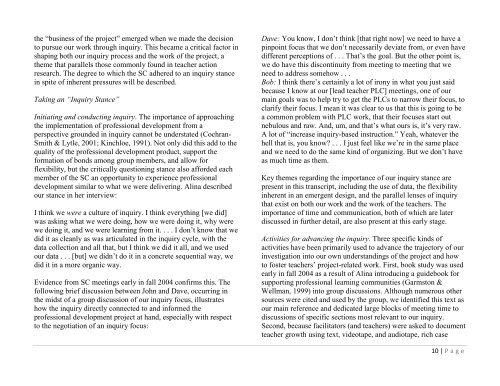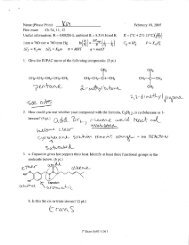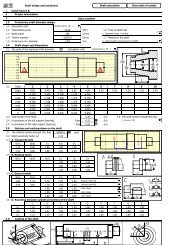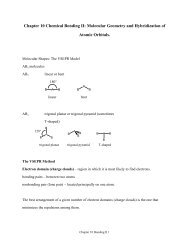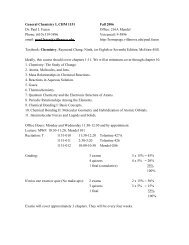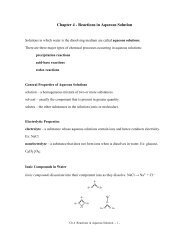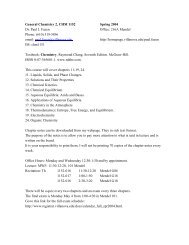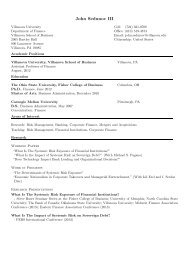the ―business <strong>of</strong> the project‖ emerged when we made the decision<strong>to</strong> pursue our work through inquiry. This became a critical fac<strong>to</strong>r inshaping both our inquiry process <strong>and</strong> the work <strong>of</strong> the project, atheme that parallels those commonly found in teacher actionresearch. The degree <strong>to</strong> which the SC adhered <strong>to</strong> an inquiry stancein spite <strong>of</strong> inherent pressures will be described.Taking an “<strong>Inquiry</strong> Stance”Initiating <strong>and</strong> conducting inquiry. The importance <strong>of</strong> approachingthe implementation <strong>of</strong> pr<strong>of</strong>essional development from aperspective grounded in inquiry cannot be understated (Cochran-Smith & Lytle, 2001; Kinchloe, 1991). Not only did this add <strong>to</strong> thequality <strong>of</strong> the pr<strong>of</strong>essional development product, support theformation <strong>of</strong> bonds among group members, <strong>and</strong> allow forflexibility, but the critically questioning stance also afforded eachmember <strong>of</strong> the SC an opportunity <strong>to</strong> experience pr<strong>of</strong>essionaldevelopment similar <strong>to</strong> what we were delivering. Alina describedour stance in her interview:I think we were a culture <strong>of</strong> inquiry. I think everything [we did]was asking what we were doing, how we were doing it, why werewe doing it, <strong>and</strong> we were learning from it. . . . I don‘t know that wedid it as cleanly as was articulated in the inquiry cycle, with thedata collection <strong>and</strong> all that, but I think we did it all, <strong>and</strong> we usedour data . . . [but] we didn‘t do it in a concrete sequential way, wedid it in a more organic way.Evidence from SC meetings early in fall 2004 confirms this. Thefollowing brief discussion between John <strong>and</strong> Dave, occurring inthe midst <strong>of</strong> a group discussion <strong>of</strong> our inquiry focus, illustrateshow the inquiry directly connected <strong>to</strong> <strong>and</strong> informed thepr<strong>of</strong>essional development project at h<strong>and</strong>, especially with respect<strong>to</strong> the negotiation <strong>of</strong> an inquiry focus:Dave: You know, I don‘t think [that right now] we need <strong>to</strong> have apinpoint focus that we don‘t necessarily deviate from, or even havedifferent perceptions <strong>of</strong> . . . That‘s the goal. But the other point is,we do have this discontinuity from meeting <strong>to</strong> meeting that weneed <strong>to</strong> address somehow . . .Bob: I think there‘s certainly a lot <strong>of</strong> irony in what you just saidbecause I know at our [lead teacher PLC] meetings, one <strong>of</strong> ourmain goals was <strong>to</strong> help try <strong>to</strong> get the PLCs <strong>to</strong> narrow their focus, <strong>to</strong>clarify their focus. I mean it was clear <strong>to</strong> us that this is going <strong>to</strong> bea common problem with PLC work, that their focuses start outnebulous <strong>and</strong> raw. And, um, <strong>and</strong> that‘s what ours is, it‘s very raw.A lot <strong>of</strong> ―increase inquiry-based instruction.‖ Yeah, whatever thehell that is, you know? . . . I just feel like we‘re in the same place<strong>and</strong> we need <strong>to</strong> do the same kind <strong>of</strong> organizing. But we don‘t haveas much time as them.Key themes regarding the importance <strong>of</strong> our inquiry stance arepresent in this transcript, including the use <strong>of</strong> data, the flexibilityinherent in an emergent design, <strong>and</strong> the parallel lenses <strong>of</strong> inquirythat exist on both our work <strong>and</strong> the work <strong>of</strong> the teachers. Theimportance <strong>of</strong> time <strong>and</strong> communication, both <strong>of</strong> which are laterdiscussed in further detail, are also present at this early stage.Activities for advancing the inquiry. Three specific kinds <strong>of</strong>activities have been primarily used <strong>to</strong> advance the trajec<strong>to</strong>ry <strong>of</strong> ourinvestigation in<strong>to</strong> our own underst<strong>and</strong>ings <strong>of</strong> the project <strong>and</strong> how<strong>to</strong> foster teachers‘ project-related work. First, book study was usedearly in fall 2004 as a result <strong>of</strong> Alina introducing a guidebook forsupporting pr<strong>of</strong>essional learning communities (Garms<strong>to</strong>n &Wellman, 1999) in<strong>to</strong> group discussions. Although numerous othersources were cited <strong>and</strong> used by the group, we identified this text asour main reference <strong>and</strong> dedicated large blocks <strong>of</strong> meeting time <strong>to</strong>discussions <strong>of</strong> specific sections most relevant <strong>to</strong> our inquiry.Second, because facilita<strong>to</strong>rs (<strong>and</strong> teachers) were asked <strong>to</strong> documentteacher growth using text, videotape, <strong>and</strong> audiotape, rich case10 | P a g e
studies <strong>of</strong> our own teachers emerged. The case study discussionswere led by the facilita<strong>to</strong>r who supplied the data <strong>and</strong> were used <strong>to</strong>address general issues <strong>of</strong> facilitation, the inquiry <strong>of</strong> the SC, <strong>and</strong>specific support <strong>to</strong> the facilita<strong>to</strong>r regarding the case. Third, datafrom the internal evaluation <strong>and</strong> data collected by the authors <strong>and</strong>other members <strong>of</strong> the SC were used <strong>to</strong> frame discussions <strong>of</strong> projectstatus <strong>and</strong> direction, particularly data related <strong>to</strong> the growthtrajec<strong>to</strong>ry <strong>of</strong> individual teachers <strong>and</strong> the teachers‘ PLCs as a whole.For each <strong>of</strong> these data sources, specific pro<strong>to</strong>cols were developed<strong>and</strong> followed for guiding the data analysis <strong>and</strong> discussion. Forexample, when discussing one chapter <strong>of</strong> the Garms<strong>to</strong>n <strong>and</strong>Wellman (1999) text, the group members were asked <strong>to</strong> highlightthe most impacting page, then paragraph, then word, <strong>and</strong>discussion was organized around this analysis. When discussingcase studies, specific pro<strong>to</strong>cols for individual <strong>and</strong> group dataanalyses were provided <strong>to</strong> facilitate attention <strong>to</strong> specific matters<strong>and</strong> <strong>to</strong> structure the nature <strong>and</strong> dynamics <strong>of</strong> subsequentconversations (McDonald, Mohr, Dichter, & McDonald, 2003).Because time was at a premium, the pro<strong>to</strong>cols also emerged fromthe need <strong>to</strong> balance efficiency with genuine, deep conversation.The following discussion from a case study presentation in March2005 provides insight in<strong>to</strong> the nature <strong>of</strong> the group‘s inquiryprocess:Tamara: So the purpose <strong>of</strong> the pro<strong>to</strong>col is <strong>to</strong> help us as aleadership PLC think about applying <strong>to</strong>ols for decision-making,which was our reading in Garms<strong>to</strong>n, <strong>to</strong> the dilemma <strong>of</strong> a PLC thatis really wallowing between looking at student work, which is thedata that they are drawing upon, <strong>and</strong> taking some action on that.Tom: I‘m going <strong>to</strong> present the dilemma <strong>and</strong> the dilemma is one <strong>of</strong>facilitation. We‘re trying <strong>to</strong> cultivate PLC dialogue, but at the sametime we need <strong>to</strong> . . . develop strategies <strong>to</strong> help PLCs get past thiswallowing between looking at data <strong>and</strong> taking some actions . . .[There is a] need <strong>to</strong> be flexible in our ability <strong>to</strong> get groups unstuck,because even though we‘re going <strong>to</strong> look at one case <strong>and</strong> thinkabout how <strong>to</strong> get them unstuck, this is just one situation, <strong>and</strong> this isgoing <strong>to</strong> come up again <strong>and</strong> again. So how can we use the <strong>to</strong>ols fordecision-making presented in Garms<strong>to</strong>n? [He refers <strong>to</strong> specificpages in the book <strong>and</strong> addresses how they relate <strong>to</strong> the pro<strong>to</strong>col.]How can we apply those decision-making <strong>to</strong>ols for groups <strong>to</strong>develop our capabilities <strong>to</strong> be able <strong>to</strong> deal with this case now, butalso other cases <strong>of</strong> your own, perhaps?The last sentence is particularly interesting because we see anexplicit duality in Tom‘s remarks regarding ―groups‖ <strong>to</strong> get―unstuck,‖ but also <strong>to</strong> develop ―our capabilities‖ for supporting theteacher PLCs. In this brief transcript, we see several inquiryprocesses, such as employing group norms that embed the use <strong>of</strong>pro<strong>to</strong>cols <strong>to</strong> facilitate processing <strong>and</strong> discussion, drawing fromprior resources <strong>and</strong> common group experiences, <strong>and</strong> using data <strong>to</strong>support the work <strong>of</strong> the teacher participants <strong>and</strong> our own growth aspr<strong>of</strong>essional developers. We now turn <strong>to</strong> a specific focus on howthe inquiry processes we employed impacted our work withteachers.Translating our new underst<strong>and</strong>ings <strong>to</strong> our work with teachers.The use <strong>of</strong> resources, such as pro<strong>to</strong>cols, that supported thefunctioning <strong>of</strong> our group were later used by project facilita<strong>to</strong>rs <strong>to</strong>support the teachers in their PLCs. For example, Lisa used theabove text analysis pro<strong>to</strong>col with her PLCs, <strong>and</strong> Tom <strong>and</strong> Ginnyused a ―looking at student work‖ pro<strong>to</strong>col during a case studydiscussion with the SC that was later shared with lead teachers byother facilita<strong>to</strong>rs. Hence, inquiring in<strong>to</strong> the essence <strong>of</strong> apr<strong>of</strong>essional development experience led <strong>to</strong> important changes inour practices as pr<strong>of</strong>essional developers (Even et al., 2003; Stein etal., 1999). However, although an important result, this directtransfer <strong>of</strong> specific skills <strong>and</strong> <strong>to</strong>ols <strong>to</strong> the work <strong>of</strong> the project wasfar less important in the context <strong>of</strong> our own pr<strong>of</strong>essional growththan was the growth in our own underst<strong>and</strong>ings <strong>of</strong> the nature <strong>of</strong>11 | P a g e


